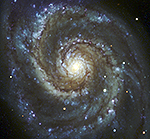
Montage Montage is an astronomical image toolkit with components for reprojection, background matching, coaddition and visualization of FITS files. It can be used as a set of command-line tools (Linux, OS X and Windows), C library calls (Linux and OS X) and as Python binary extension modules.
The Montage source is written in ANSI-C and code can be downloaded from GitHub ( https://github.com/Caltech-IPAC/Montage ). The Python package can be installed from PyPI ("</i>pip install MontagePy"). The package has no external dependencies. See http://montage.ipac.caltech.edu/ for details on the design and applications of Montage.
MontagePy.main modules: mMakeHdr¶
Much of the Montage processing is based on the specification of an output image as captured in an ASCII file version of the output FITS header. Sometimes such a header is cloned from an existing FITS file and sometimes created from scratch using an editor or the utility mHdr.
Another common approach is the create a header is to base it on a table of source locations or image metadata by drawing a bounding box around the table contents. mMakeHdr reads through a table and determines such a bounding box using a spherical geometry variant of the rotating calipers technique from computational geometry. The box can either be of overall minimum size or can include the constraint that North be oriented upward in the image.
from MontagePy.main import mMakeHdr, mViewer
help(mMakeHdr)
mMakeHdr Example¶
The principle parameters for mMakeHdr are the table file to be fit (either just coordinates or image metadata) and the output header file name. There are optional settings for specifying the coordinate system to use, the pixel scale (the default is derived from the table), and whether the image should be "North-up".
We have a set of images retrieved from the 2MASS archive that overlap with a 1-degree box around M17. Using the metadata from those image and mMakeHdr, we will derive a header file which is somewhat larger, since it will bound the entirity of those images:
rtn = mMakeHdr('M17/remote.tbl', 'work/M17/bounding.hdr')
print(rtn)
Header¶
Here is the generated header:
with open('work/M17/bounding.hdr', 'r') as fin:
print(fin.read(), end='')
Error Handling¶
If mMakeHdr encounters an error, the return structure will just have two elements: a status of 1 ("error") and a message string that tries to diagnose the reason for the error.
For instance, if the user asks for a non-existent input table:
rtn = mMakeHdr('M17/unknown.tbl', "work/M17/bounding.hdr")
print(rtn)
Classic Montage: mMakeHdr as a Stand-Alone Program¶
mMakeHdr Unix/Windows Command-line Arguments¶
mMakeHdr can also be run as a command-line tool in Linux, OS X, and Windows:
Usage: mMakeHdr [-d level] [-s statusfile] [-p(ixel-scale) cdelt | -P maxpixel] [-e edgepixels] [-n] images.tbl template.hdr [system [equinox]] (where system = EQUJ|EQUB|ECLJ|ECLB|GAL|SGAL)
If you are writing in C/C++, mMakeHdr can be accessed as a library function:
/*-***********************************************************************/
/* */
/* mMakeHdr */
/* */
/* Create the best header 'bounding' a table or set of tables (each */
/* with image metadata or point sources). */
/* */
/* char *tblfile Input image metadata table or source table */
/* or table of tables */
/* */
/* char *template Output image header template */
/* */
/* char *csys Coordinate system (e.g. 'EquJ', 'Galactic'). */
/* Fairly forgiving */
/* */
/* double equinox Coordinate system equinox (e.g. 2000.0) */
/* */
/* double pixelScale Pixel scale in degrees */
/* */
/* int northAligned Defaults to minimum bounding box around */
/* input images. This forces template to be */
/* north-aligned */
/* */
/* double pad Optional extra padding around output template */
/* */
/* int isPercentage Pad is in pixels by default. This changes */
/* that to a percentage of the image size */
/* */
/* int maxPixel Setting the pixel scale can result in really */
/* big images. This forces a maximum number */
/* of pixels in NAXIS1, NAXIS2 */
/* */
/* int debug Debugging output level */
/* */
/*************************************************************************/
struct mMakeHdrReturn *mMakeHdr(char *tblfile, char *template, char *csysin, double equinox, double pixelScale,
int northAligned, double pad, int isPercentage, int maxPixel, int debugin)
Return Structure
struct mMakeHdrReturn
{
int status; // Return status (0: OK, 1:ERROR)
char msg [1024]; // Return message (for error return)
char json[4096]; // Return parameters as JSON string
char note[1024]; // Cautionary message (only there if needed).
int count; // Number of images in metadata table.
int ncube; // Number of images that have 3/4 dimensions.
int naxis1; // X axis pixel count in output template.
int naxis2; // Y axis pixel count in output template.
double clon; // Center longitude for template.
double clat; // Center latitude for template.
double lonsize; // Template dimensions in X.
double latsize; // Template dimensions in Y.
double posang; // Rotation angle of template.
double lon1; // Image corners (lon of first corner).
double lat1; // Image corners (lat of first corner).
double lon2; // Image corners (lon of second corner).
double lat2; // Image corners (lat of second corner).
double lon3; // Image corners (lon of third corner).
double lat3; // Image corners (lat of third corner).
double lon4; // Image corners (lon of fourth corner).
double lat4; // Image corners (lat of fourth corner).
};